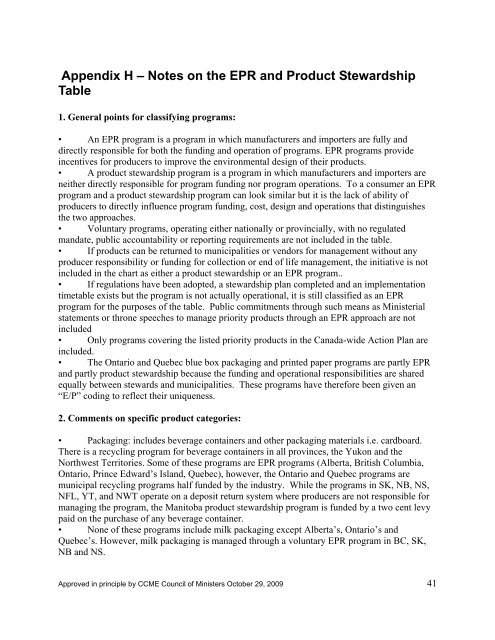Canada-Wide Action Plan for Extended Producer ... - CCME
Canada-Wide Action Plan for Extended Producer ... - CCME
Canada-Wide Action Plan for Extended Producer ... - CCME
Create successful ePaper yourself
Turn your PDF publications into a flip-book with our unique Google optimized e-Paper software.
Appendix H – Notes on the EPR and Product Stewardship<br />
Table<br />
1. General points <strong>for</strong> classifying programs:<br />
• An EPR program is a program in which manufacturers and importers are fully and<br />
directly responsible <strong>for</strong> both the funding and operation of programs. EPR programs provide<br />
incentives <strong>for</strong> producers to improve the environmental design of their products.<br />
• A product stewardship program is a program in which manufacturers and importers are<br />
neither directly responsible <strong>for</strong> program funding nor program operations. To a consumer an EPR<br />
program and a product stewardship program can look similar but it is the lack of ability of<br />
producers to directly influence program funding, cost, design and operations that distinguishes<br />
the two approaches.<br />
• Voluntary programs, operating either nationally or provincially, with no regulated<br />
mandate, public accountability or reporting requirements are not included in the table.<br />
• If products can be returned to municipalities or vendors <strong>for</strong> management without any<br />
producer responsibility or funding <strong>for</strong> collection or end of life management, the initiative is not<br />
included in the chart as either a product stewardship or an EPR program..<br />
• If regulations have been adopted, a stewardship plan completed and an implementation<br />
timetable exists but the program is not actually operational, it is still classified as an EPR<br />
program <strong>for</strong> the purposes of the table. Public commitments through such means as Ministerial<br />
statements or throne speeches to manage priority products through an EPR approach are not<br />
included<br />
• Only programs covering the listed priority products in the <strong>Canada</strong>-wide <strong>Action</strong> <strong>Plan</strong> are<br />
included.<br />
• The Ontario and Quebec blue box packaging and printed paper programs are partly EPR<br />
and partly product stewardship because the funding and operational responsibilities are shared<br />
equally between stewards and municipalities. These programs have there<strong>for</strong>e been given an<br />
“E/P” coding to reflect their uniqueness.<br />
2. Comments on specific product categories:<br />
• Packaging: includes beverage containers and other packaging materials i.e. cardboard.<br />
There is a recycling program <strong>for</strong> beverage containers in all provinces, the Yukon and the<br />
Northwest Territories. Some of these programs are EPR programs (Alberta, British Columbia,<br />
Ontario, Prince Edward’s Island, Quebec), however, the Ontario and Quebec programs are<br />
municipal recycling programs half funded by the industry. While the programs in SK, NB, NS,<br />
NFL, YT, and NWT operate on a deposit return system where producers are not responsible <strong>for</strong><br />
managing the program, the Manitoba product stewardship program is funded by a two cent levy<br />
paid on the purchase of any beverage container.<br />
• None of these programs include milk packaging except Alberta’s, Ontario’s and<br />
Quebec’s. However, milk packaging is managed through a voluntary EPR program in BC, SK,<br />
NB and NS.<br />
Approved in principle by <strong>CCME</strong> Council of Ministers October 29, 2009 41
















